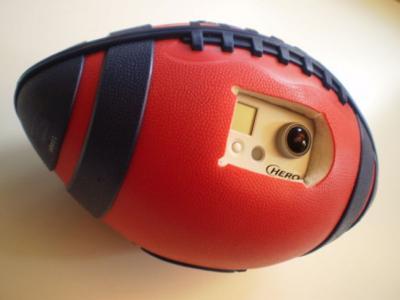If you liked FoxTrax, that glowing hockey puck shooting around the ice during NHL games, you will love what engineers from Carnegie Mellon University and the University of Electro-Communications (UEC) in Tokyo have done: they put a camera inside a football.
The camera is embedded in the side of a rubber-sheathed plastic foam football can record video while the ball is in flight. Want a ball's-eye view of the playing field? Now you have it. But because a football can spin at 600 rpm, the raw video is an unwatchable blur so the researchers also developed a computer algorithm that converts the raw video into a stable, wide-angle view.
Kris Kitani, a post-doctoral fellow in Carnegie Mellon's Robotics Institute, is aware that a football league is unlikely to approve camera-embedded footballs for regular play. Even so, the BallCam might be useful for TV, movie productions or training purposes.

BallCam: A small, wireless camera inside a plastic foam football to obtain video while the spiraling ball is in flight. Credit: Carnegie Mellon Robotics Institute
Co-author Kodai Horita from University of Electro-Communications (UEC) in Tokyo, a visiting graduate student last year at the Carnegie Mellon University Robotics Institute, will present a paper about BallCam on March 8 at the Augmented Human International Conference in Stuttgart, Germany.
Kitani said BallCam was developed as part of a larger exploration of digital sports. "We're interested in how technology can be used to enhance existing sports and how it might be used to create new sports," he explained. In some cases, athletic play may be combined with arts or entertainment; a camera-embedded ball, for instance, might be used to capture the expressions on the face of players as they play catch with it.
Other researchers have developed throwable cameras that produce static images or use multiple cameras to capture stabilized video. The BallCam system developed by Kitani and Horita, along with Hideki Sasaki and Professor Hideki Hoike of UEC, uses a single camera with a narrow field of view to generate a dynamic, wide-angle video.
Dizzy yet?
When the ball is thrown in a clean spiral, the camera records a succession of frames as the ball rotates. When processing these frames, the algorithm uses the sky to determine which frames were made when the camera was looking up and which were made when it was looking down. The upward frames are discarded and the remaining, overlapping frames are stitched together with special software to create a large panorama. Similar stitching software is used by NASA to combine images from Mars rovers into large panoramas and is increasingly found in digital cameras.
The algorithm also makes corrections for some distortions in the image that twist yard lines and occur because of the speed of the ball's rotation. Further work will be necessary to eliminate all of the distortion, Kitani said, and a faster camera sensor or other techniques will be needed to reduce blurring. Multiple cameras might also be added to the football to improve the finished video.




Comments